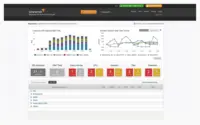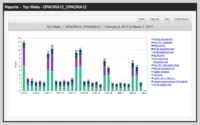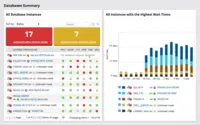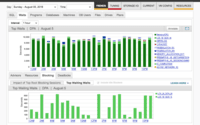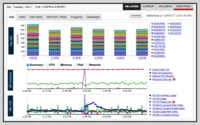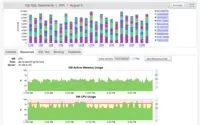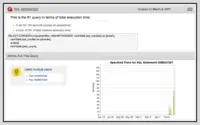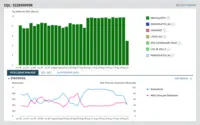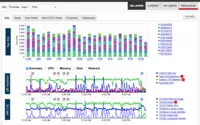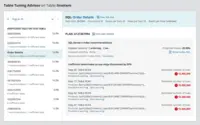Overview
What is SolarWinds Database Performance Analyzer?
SolarWinds Database Performance Analyzer (DPA) enables deep visibility into database performance and expert advice for performance optimization and tuning.What can you monitor with DPA? OracleOracle ExadataOracle EBSMicrosoft SQL Server Azure SQL DatabaseAzure SQL Database Managed InstanceMySQLDB2 SAP ASE AuroraMariaDBDPA monitors…
Easy to use and provides more details on the queries
DPA Delivers Tremendous Value
Hands Down: SolarWinds Database Performance Analyzer Beats SQL Profile and Database Engine Tuning Advisor
SolarWinds Database Performance Analyzer is a great addition to your DBA and Development toolkit
SolarWinds DPA - covers all/most of your SQL monitoring needs
Top of Class Database Performance Monitoring and Tuning Advisor!
SolarWinds Database Performance Analyzer - Recommended
DPA is hell lot of a Business for Database world
SolarWinds DPA should be on every DBA's wishlist.
SolarWinds DPA is a constant companion making sense of database performance
Awesome Tool for SQL Performance Tuning
SolarWinds DPA is a great product to visually see the health of the databases and make a proactive monitoring and root cause analysis
DPA: FTW.
SolarWinds DPA saves the day every time
SolarWinds Database Performanc Analyzer - DPA Saves The Day!
Awards
Products that are considered exceptional by their customers based on a variety of criteria win TrustRadius awards. Learn more about the types of TrustRadius awards to make the best purchase decision. More about TrustRadius Awards
Reviewer Pros & Cons
Pricing
What is SolarWinds Database Performance Analyzer?
SolarWinds Database Performance Analyzer (DPA) enables deep visibility into database performance and expert advice for performance optimization and tuning. What can you monitor with DPA? Oracle Oracle Exadata Oracle EBS Microsoft…
Entry-level set up fee?
- Setup fee optional
Offerings
- Free Trial
- Free/Freemium Version
- Premium Consulting/Integration Services
Would you like us to let the vendor know that you want pricing?
28 people also want pricing
Alternatives Pricing
What is SolarWinds SQL Sentry?
SolarWinds SQL Sentry is designed to help data professionals optimize SQL Server database performance in physical, virtual, and cloud environments. SQL Sentry delivers metrics to help users find and fix database performance problems and provides scalability, boasting demonstrated success monitoring…
What is dbForge Studio (Edge)?
dbForge Studio is provided by Devart and is a universal front-end client for database management, administration and development. Devart's GUI tool provides utilities to compare, synchronize, and back up databases (e.g. MySQL, Oracle, SQL Server, PostgreSQL, etc.) with scheduling, and includes the…
Product Details
- About
- Integrations
- Competitors
- Tech Details
- Downloadables
- FAQs
What is SolarWinds Database Performance Analyzer?
- Oracle
- Oracle Exadata
- Oracle EBS
- Microsoft SQL Server
- Azure SQL Database
- Azure SQL Database Managed Instance
- MySQL
- DB2
- SAP ASE
- Aurora
- MariaDB
What makes DPA stand out:
- Quick, easy, and reliable performance
troubleshooting available in real time and historically
- Machine learning anomaly analysis to bring intelligence to go beyond traditional threshold based analysis
- Find inefficient workloads, aggregated by table, for indexing opportunities—an “X marks the spot” tuning analysis
- Cross-platform database support for a single-pane-of-glass view into your environment
- Blocking analysis: what is blocking and a hierarchy of what is being blocked, plus overall impact
- PerfStack™ integration with other SolarWinds products for more complete visibility (applications, servers, storage, hypervisor, network, and more)
- Agent-less architecture with the ability to scale from a few instances to thousands, low 1% average overhead
SolarWinds Database Performance Analyzer Features
- Supported: Database monitoring
- Supported: Tuning advisors for queries, workload, and indexes aggregated at the table level
- Supported: Correlated resource metrics for easy diagnosis of hardware constraint impacts on end-users
- Supported: Detailed blocking analysis for contention bottlenecks
- Supported: I/O activity tracking at the drive/mount and file level
- Supported: Alerts and reports
- Supported: DPA Central to manage large and/or distributed environments
- Supported: Always On Availability Group and RAC insights
SolarWinds Database Performance Analyzer Screenshots
SolarWinds Database Performance Analyzer Videos
Watch Product Overview
SolarWinds Database Performance Analyzer Integrations
- SolarWinds Server & Application Monitor
- SolarWinds Virtualization Manager (VMAN)
- SolarWinds Storage Resource Monitor (SRM)
- SolarWinds Network Performance Monitor (NPM)
- SolarWinds NetFlow Traffic Analyzer (NTA)
- SolarWinds Network Configuration Manager (NCM)
- SolarWinds IP Address Manager (IPAM)
- SolarWinds VoIP & Network Quality Manager (VNQM)
- SolarWinds Web Performance Monitor (WPM)
- SolarWinds User Device Tracker
SolarWinds Database Performance Analyzer Competitors
SolarWinds Database Performance Analyzer Technical Details
| Deployment Types | On-premise, Software as a Service (SaaS), Cloud, or Web-Based |
|---|---|
| Operating Systems | Windows, AWS Marketplace app |
| Mobile Application | No |
SolarWinds Database Performance Analyzer Downloadables
Frequently Asked Questions
Comparisons
Compare with
Reviews and Ratings
(227)Community Insights
- Pros
- Cons
- Recommendations
User-Friendly Interface: Users appreciate the SolarWinds Database Performance Analyzer for its straightforward and easy-to-understand interface. They find it intuitive and user-friendly, even for new users with minimal training.
Real-Time Analysis and Support: The tool's real-time analysis capabilities and support services are highly valued by users. They mention that it helps them promptly identify and resolve performance issues in SQL databases, such as errors, long-running queries, or system-blocking problems.
Wide Range of Supported Databases: Users find the extensive range of supported databases to be a valuable feature of the tool. It allows them to monitor and analyze the performance of multiple databases from one centralized interface.
Dated and Confusing User Interface: Several users have expressed frustration with the user interface, describing it as dated, confusing, and difficult to navigate. They suggest that the user interface could be more user-friendly and have a reduced learning curve. Some users also mentioned that the navigation can be unintuitive and sometimes tough, and that some items can be confusing to find again. Overall, improvements in the cosmetic aspects of the user interface are needed.
Lack of Reporting Flexibility: According to some users, there is a lack of flexibility in both dashboard customization and reporting capabilities. They feel that the reporting feature needs improvement to provide more options for customization and analysis. This limitation hinders users' ability to obtain meaningful insights from their data.
High Cost: The cost of the software has been a major complaint among some users, particularly when it comes to adding additional instances. These users mention that the licensing timeline needs improvement as adding new instances becomes cost-prohibitive during certain periods of the year. The high cost associated with using this software can limit its accessibility for businesses operating on tight budgets.
Users highly recommend trying the free trial and evaluating SolarWinds DPA before purchasing. They suggest taking advantage of the free demo and training resources provided by SolarWinds. Users advise implementing SolarWinds DPA for monitoring and analyzing databases, especially for those who are just learning. The software is also recommended for DBAs in small to medium businesses and for integrating with other SolarWinds products for better data analysis. Additionally, users suggest comparing it with Idera offerings for SQL performance monitoring and highlighting it to DBAs as they will likely find value in it.
Attribute Ratings
- 8.6Likelihood to Renew4 ratings
- 9.1Availability1 rating
- 9.1Performance1 rating
- 9Usability6 ratings
- 9.3Support Rating6 ratings
- 7.3Implementation Rating2 ratings
- 7.3Configurability1 rating
- 8.2Product Scalability1 rating
- 8.2Ease of integration1 rating
- 9.1Vendor pre-sale1 rating
- 9.1Vendor post-sale1 rating
- 10Solarwinds Premier Support Rating10 ratings
- 7.3SolarWinds Smart Start Support Rating1 rating
Reviews
(1-25 of 46)DPA Delivers Tremendous Value
DPA is a *tremendous* tool. It provides a deep dive across all critical metrics on our ORA RDS & EC2. I find the table/query advisories to be of great use.
Would deploy across any DB if I could - the info is gold.
- Drill-down into expensive queries.
- Table/Query Advisor.
- Easy to interpret graphing.
Hands Down: SolarWinds Database Performance Analyzer Beats SQL Profile and Database Engine Tuning Advisor
- Identifies objects causing bottleneck by real wait time
- Identifies specific section of a large query that needs attention
- Lets you see what index is actually being used
- Helps you see if CPU, RAM or DISK is the limiting resource
- View Plan Details is actually a bit weaker than SSMS because all the lines are the same width
- The "View SQL Text" viewer could be fancier - but it does clearly identify the problem section
- The product is great at visualizing the data you need for administration and performance tuning, making it understandable in seconds. A database like Oracle has AWR reports - many pages long, all text, hard to read. SQL Server has dynamic management views - good stuff but not so easily accessible. SolarWinds Database Performance Analyzer (DPA) lays it out so it is quickly comprehensible and actionable.
- DPA tells us what's really going on. Example: the developer says this stored procedure is running super slowly in this RDBMS but runs like lightning on this other one. They've tried to tune it to no avail. So we spend just a few minutes with DPA investigating the situation and we find that the stored proc is running fine. Instead, it is the application's attempt to access the metadata about the proc that is slow. This led to caching the metadata and now the 'slow' proc is running great! Without DPA it would have been a long time before we got to looking at the right code to tweak.
- It's great that we can use the built-in alerts functionality to create custom alerts. The custom alerts can gather information for the databases we are monitoring or from the data DPA collects which go beyond the database and into other relevant pieces like the OS, storage and the network.
- It's a great product - they do most things right. Maybe I'll say keep working on the UI so I can get to the info I need with even fewer clicks.
- One feature a competitor of DPA has that looks useful is mapping out when jobs are run and being able to map that time-wise against when problems occur.
Awesome Tool for SQL Performance Tuning
- Tells you which statements in which stored procedures need work or are catastrophic (if that applies).
- Helps you focus attention on what really needs work, very efficiently.
- The UI gets clunky if you have lots of servers to monitor.
- It doesn't really rank problems across multiple servers.
DPA: FTW.
- Near-instantaneous feedback on problem queries
- Allows us to evaluate changes in the application or its stored procedures over time
- We can drill down to the end-user level to identify potential issues, important with > 2000 sessions daily
- Can't think of any feature or ops related issues. Prior complaints have all been addressed in newer updates.
- Only main complaint is cost -- we would adopt for other servers if the incremental cost wasn't so high for a few additional instances (we have 3 servers we would like to use DPA with, but can't justify the x3 pricing per instance).
SolarWinds Database Performanc Analyzer - DPA Saves The Day!
- Great Visual Display from Console - at a glance you can tell if there are issues
- Drill down on a single query to get recommendations on tuning the statement
- Automated Notifications, which can be customized / modified
- Live view on Storage I/O
- Resource Monitor is a plus - CPU Utilization - Instance and OS
- Recently addressed - protect the supply chain
- I can't keep up with all the improvements to tell you the truth ... Database Performance Analyzer is Awesome
- Demo Database Performance Analyzer - you will not be let down
- Join THWACK so you get the most out of your product. Great forum to get answers from colleges that may be experiencing the same issue!
- Excellent for trending SQL Performance over time.
- Excellent for monitoring deadlocks and blocking.
- Good for trending SQL query changes over time.
- It would be nice to have more built-in alerting capabilities.
- Indexing recommendations are also somewhat unclear. I have seen areas that say you could improve performance on a table for example but not giving any additional details beyond that.
- More in-depth recommendations, other tools like Idera Diagnostic Manager I feel are stronger in this area.
Alerting and notifications are not as strong as some other tools I have used.
Blocking and deadlocking features/analysis could be improved also.
SolarWinds Database Performance Analyzer solves problems that OEM can't even recognize are occurring
- Maintains historical SQL execution data, enabling forensic analysis
- Has the ability to slice and dice the data so that you can drill down to the execution of a single SQL statement being executed by a stored procedure
- Alerts to when the consumption pattern changes
- Shows historical average run times against the current, illustrating problems when they arise
- Provides tuning advice based on best practices
- Everything is displayed visually, if you need detailed metrics, you have to extract manually, it could use a report writer with export to Excel.
- When a SQL statement is very long running, i.e. longer than the display interval, the display says that there are no statistics, it should on the other hand, show that the SQL statement is still running.
- When you name a SQL statement, it should be by DB, rather than global
Very appropriate for alerting to performance issues before they become critical
Can be challenging when monitoring an Oracle active-active RAC database, as each instance is effectively a separate database.
Solarwinds DPA - a DBA's MVP!
- Insight into query wait times
- Ability to view Disk IO
- Historical trending of wait times
- Dated UI
- Development servers are not free
- Dashboard visualization of stats requires Solarwinds Performance Monitor (Included with Orion)
One thing to note is that you will need to host DPA yourself, it's not a cloud solution (although you can host it in the cloud if you prefer). This also means you have complete control over where this data resides.
SolarWinds Database Performance Analyzer Review
- We have set up alerts on long-running queries, blocking other queries, deadlocks, instance availability, unused indexes, etc.
- The status summary is useful to see the load on the server.
- Deadlocks alert can be improved to show what queries were in the deadlock, so we can improve our solution.
- Deadlocks alert can be improved to show what queries were in the deadlock, so we can improve our solution.
- We never got to setup https using the documentation provided by solar winds. We still keep getting https error when we access our DPA site.
- A better technical customer service would help.
Real ROI that added a 9 to our uptime.
- Alerts us of current issues affecting system performance
- Alerts us of potential issues that will affect system performance
- The licensing timeline needs improvement. Adding new instances becomes cost-prohibitive at some times of the year due to the locked-down renewal period.
DPA user
- Highlights slow queries.
- Drill down options to the second for troubleshooting.
- Better suggestions for indexes.
Invaluable, Trusted Performance Diagnostics
- Automated Collection into a queryable repository - Hands-off, detailed collection assures us that the bulk of any performance issues are noted, so that their data can be presented on-demand in a readily consumable form. Drill-into features enable detailed analysis.
- Performance Trend Analysis - Monthly top-consumers visualized in meaningful stacked-charts, with anomaly highlights and per-query, per-day detail enables hot-spot drill-down analysis.
- Resource Utilization Warnings - Best-practice warning and critical measure applied to all facets, visualized in real-time are essential features that trigger troubleshooting.
- Usability within the Trends and Current pages need improvement - Version 11 introduced a new Tuning feature, and changed the way one could quickly name a query and chose whether it would be of further interest, or is more infrastructure-oriented such that exclusion is warranted. Usability took a downward slide.
- Resource Utilization has preset periods which, for longer durations, overly smooth charts. Custom periods are much needed via the UI, rather than repository-querying.
- Storage analysis, similar to resource usage, needs custom periods and far greater ability to delineate between drives and files than v11 currently offers. (One rarely uses the Storage I/O tab)
Would be lost without it
- Allows instant identification of highest impact performance issues
- Provides visibility of database load across the application
- Easy to configure and use
- It's a great product. I really can't identify any cons.
Solarwinds DPA gives your non-DBAs the ability to look inside and diagnose database problems!
- Pinpoints potential issues with databases.
- Suggests remediation for these problems.
- Allows you to narrow down to particular points in time where the problems were observed.
- It does take a while to gather enough data to suggest problems and fixes. Generally speaking, while you'll get some data back in an hour or two, you want at least 2 days of monitoring to get the best results.
- Licensing is a bit restrictive.
- Switching licenses between monitored nodes is a bit annoying.
Solar Winds DPA provides the best trend charts
- Monitors both SQL query performance and back end VM resources.
- Easy to read trend charts, bottlenecks or spikes show up immediately.
- East to drill-down into specific issues.
- Very good settings for alerts.
- Poor interface for managing alert times or blocking out alerts at times of the week. Very tedious process.
DPA: Great web application for wait stats and trends. Not the tool for those needing actionable alerts.
- Capturing wait statistics is a great way to monitor performance on a SQL Server instance. This is the main source of info for DPA.
- Web app: no client install required. Easy to login from a web browser, share info and manage everything from a browser tab.
- Drill-downs from one time interval to seconds to see database activity is intuitive and easy to use.
- Alerts seem to be lacking in DPA compared to competitor's tools. They can be setup but are not quite as easy or as helpful as some other tools I have used.
- Grooming/pruning the repository database isn't very easy. We don't manage a lot of instances but our repo DB has grown pretty significantly.
- At times when I am drilled-down to a chart, it can be difficult to navigate around from that point to another time range/query/metric.
Happy customers, much time saved
- Detecting blocking
- Showing missing index information
- Highlighting the most expensive queries being run in your system
- Giving a daily summary of issues
- Showing performance history over a long period of time
- The GUI is a little clunky, could do with updating and make it responsive
- A mobile app would be great, to keep an eye on things on the go
- Perhaps a cut-down version, as sometimes there's just TOO much information!
NCTradeToolReview
- Ability to drill down to wait for the issue and have a clear path as to what may be causing the issue.
- Ability to quickly add a new target and the ease of installation and upgrades.
- Reporting features to group my most troublesome customers into a daily report in one email.
- Excellent customer support on any issues I can't immediately solve.
- At this time it solves all my needs, and it appears that your folks have the pulse of this tool as the releases always give me something better to use.
Great alternative for Oracle Enterprise Manager
- monitoring our Oracle RAC performance
- searching for performance bottlenecks
- analyzing historical data and trends
- solving developers problems
- It's super helpful when hunting down problems with performance.
- It's easy to install and configure.
- It doesn't require crazy computation power or tons of memory.
- DBA-friendly.
- GUI/UI could be more modern.
- Pricing: it's reasonable but not cheap.
- Deep integration with AWS managed databases would be really nice.
My DPA-review
DPA makes it possible for me to be proactive. I find the DPA-GUI to be very user-friendly and easy to understand even without reading the manual.
- SQL-tuning advice. It's easy to locate the most inefficient SQL-staements as they are all graded. You just click and drill-down to see both the SQL-statements and statistics. That info will most likely give you enough knowledge to solve the issue, for example by adding an extra index.
- The monitoring of the database by setting up your own alerts in all kind of categories. For example, alerts when tablespaces are running full or when disk/CPU load are too high or if the server becomes unavailable.
- The possibilty to browse the repository and see trends. You can see exactly when problems are starting and see if the changes you make has an effect in the time to come.
- The license-management seems difficult to use, and I always find that I need to contact SolarWinds when upgrading server, etc.
Useful database monitoring tool
- We use this software to identify real-time performance problems such as errors, long-running queries or problems that are blocking the system.
- We use this software to review previous SQL Server queries/performance.
- When there is an issue with any Server and I need to quickly narrow down to the right place of the root cause, this is a tool that allows me to focus on the right places and remove all sorts of noise from our data.
- Cannot easily find a query using a "text search" without detailed knowledge of the underlying SQL database "repository" that is used to display the data in each product.
- On the ad-hoc plan tab, for any given plan we have to drill down each SQL manually one by one. It would be goOd to have some kind of summary popup/tool-tip when we hover over the plan in DPA.
Great tool for a DBA
- Shows the database status in a single page.
- Enables simple drilling into different database problem areas (CPU, ram, disks, sessions, etc.).
- Regularly finds top queries that can be improved.
- It would be nice if it could work with Oracle's SQL Tuning Advisor.
- Problem categorization.
- Problem identification.
- Serious trending analysis.
- When presenting possible sources of issues, it may be better to first give a list overview, and then proceed to drill down into the details.
- Quickly points out what is slowing down our SQL server
- Provides daily statistics on most ran queries and their wait time
- Operates flawlessly with no maintenance
- Sometimes it cannot tell the SQL query text - I believe its when Entity Framework SQL is being ran
- Email notification when a SQL statement starts "killing" the whole server
- Full text search of specific SQL termS in all of the SQL code that it has captured

